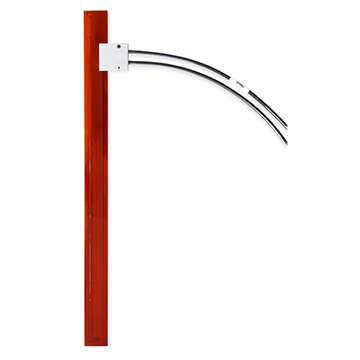
STP01 accurately measures the temperature profile of the soil at 5 depths close to its surface. It is used for scientific grade surface energy balance measurements. The sensor is buried and usually cannot be taken to the laboratory for calibration. The on-line self-test using the incorporated heating wire offers a solution to verify STP01’s measurement stability.
Introduction
STP01 soil temperature profile sensor offers an accurate temperature difference measurement at five measurement locations at 0.02 , 0.05, 0.1, 0.2 and 0.5 m below the soil surface. It also has a well specified and fixed distance between the measurement locations. STP01 contains 5 matched thermocouples, at locations A to E in figure 5, and one reference temperature sensor (Pt100 type) at location E at 0.5 m depth. By having the reference temperature measurement in the sensor and only measuring differential thermocouple voltages (relative to the reference at 0.5 m), the uncertainty of the temperature difference measurement is very low: ± 0.02 °C is attainable. Simple copper-conductor signal wire is used in STP01’s cable. As an extra, a heating wire is incorporated in STP01. Analysis of the temperature change during the heating interval serves as a self-test. Soil temperature sensors are preferably left in the soil for as long as possible, so that the soil properties become representative of natural conditions. Using self-testing, the user no longer needs to take sensors to the laboratory to verify their stable performance. The result is a much improved accuracy & quality assurance of the measurement relative to measurements with conventional sensor types.
STP01 advantages
The STP01 has several advantages over other designs:
• high accuracy, scientific measurement of soil energy balance, with a high level of data quality assurance• high accuracy K/m temperature gradient measurement by accurate positioning of the thermocouple joints (± 0.001 m), and accurate temperature difference measurement (± 0.05 K)
• high accuracy and stability of the relative distance between sensors (± 0.0005 m)
• thin, 0.6 x 10-3 m thickness, construction which leaves the soil structure intact
• simple copper-core signal wire; no special connectors needed
• selft-test saves servicing time
Suggested use
• high accuracy, scientific grade measurement of the soil energy balance, with a high level of data quality assuranceDatalogger compatibility
Sensors made by Hukseflux are designed for compatibility with the most commonly used datalogger models. For many models we have example programs and wiring diagrams available. Solutions for measurement and control: See the STP01 manual or inquire at Hukseflux. Example programs for Campbell Scientific CR10X and CR1000 are available.
Installation
For ease of installation with a minimum of disturbance of the local soil, Hukseflux offers IT01 insertion tool.
Options
• longer cable (2 x), in multiples of 5 m, cable lengths above 20 m in multiples of 10 m• insertion tool IT01












